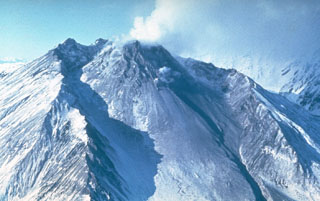Report on Bezymianny (Russia) — 11 December-17 December 2019
Smithsonian Institution / US Geological Survey
Weekly Volcanic Activity Report, 11 December-17 December 2019
Managing Editor: Sally Sennert.
Please cite this report as:
Global Volcanism Program, 2019. Report on Bezymianny (Russia) (Sennert, S, ed.). Weekly Volcanic Activity Report, 11 December-17 December 2019. Smithsonian Institution and US Geological Survey.
Bezymianny
Russia
55.972°N, 160.595°E; summit elev. 2882 m
All times are local (unless otherwise noted)
Activity at Bezymianny began to increase at the beginning of December, characterized by nighttime crater incandescence, strong fumarolic emissions, a lava flow, and gradually increasing temperatures of a satellite-detected thermal anomaly. KVERT increased the Aviation Color Code to Orange (the second highest level on a four-color scale) on 13 December.
Geological Summary. The modern Bezymianny, much smaller than its massive neighbors Kamen and Kliuchevskoi on the Kamchatka Peninsula, was formed about 4,700 years ago over a late-Pleistocene lava-dome complex and an edifice built about 11,000-7,000 years ago. Three periods of intensified activity have occurred during the past 3,000 years. The latest period, which was preceded by a 1,000-year quiescence, began with the dramatic 1955-56 eruption. This eruption, similar to that of St. Helens in 1980, produced a large open crater that was formed by collapse of the summit and an associated lateral blast. Subsequent episodic but ongoing lava-dome growth, accompanied by intermittent explosive activity and pyroclastic flows, has largely filled the 1956 crater.

